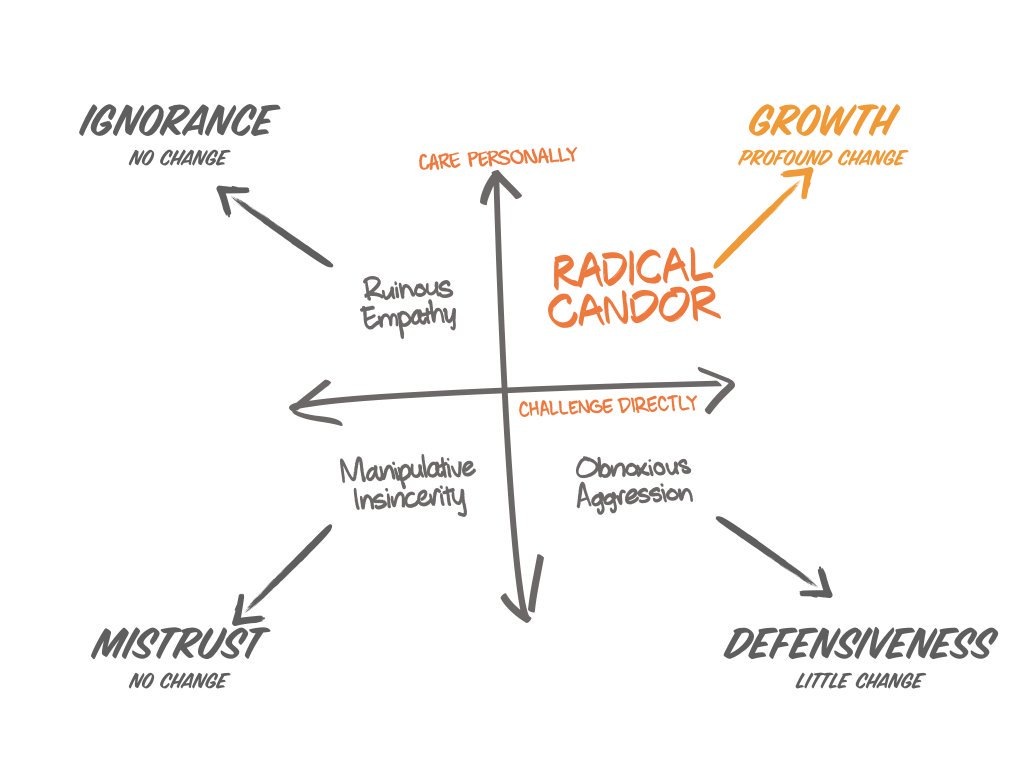Giving and Receiving Feedback
Be a Kickass Mentor Without Losing Your Humanity
Giving and receiving feedback is a skill that can be challenging to develop. While there are a lot of models out there that specifically address feedback, at RockEDU we really like the Radical Candor approach. Based on Kim Scott’s book by the same name, this strategy emphasizes striking a balance between caring personally, and challenging directly. In using this strategy, you can avoid being overly empathetic (the “wet noodle” syndrome), or being aggressive and/or insincere. Below is a schematic from Kim Scott’s work summarizing the care-challenge spectrum.

Image from https://www.radicalcandor.com
The formula for Radical Candor is simple: pay attention to your mentee’s work performance while also getting to know your mentee on a human level. Of course this is not to say that you need to be best friends with your mentee — but having some idea of their home life, hobbies, personal aspirations, or whatever it is that floats their boat can help you find effective ways to deliver feedback. This approach involves being critical of both wins and losses, while maintaining a connection to humanity. There is always room for improvement, and overall general success should not prevent us, as mentors, from pointing out how something can be iterated on to improve it. However, it is not just about delivering feedback. The Radical Candor model also involves opportunity for you to receive feedback, just as much as you give it. This gets back to the Adaptive Action plan model, which emphasizes regular check-ins for assessing progress, and responding accordingly.
The Radical Candor model also reminds me of how the most influential leaders can simultaneously exude strength (can challenge directly) and warmth (can care personally). There are several celebrities who fall into this category, and could serve as examples or even role models as you work to meet your full mentorship potential. For example, by watching how Michelle Obama or Jacinda Ardern operate in the public eye, we can pick up tips and strategies for presenting ourselves as mentors who can provide feedback in straightforward ways without sacrificing the warmth we have the capacity to emit.
Maximizing Efforts for Giving and Receiving Feedback
Giving and receiving feedback hits on nearly all aspects of leadership, and is an essential component for making progress in your mentorship — both as a professional, and in your science. To make this point, imagine a time in your scientific career where you did not get the feedback you wanted, and how this impacted the way in which you moved forward. Now imagine what might have happened if you had a mentor give you the feedback you needed to hear in order to get where you needed to be. Can you identify the disconnect?
Generally speaking feedback should be given and received in a way that is timely, accurate, and actionable. This latter point is important because unless you can articulate a way to adjust, or help your mentee brainstorm a way to address a specific challenge, feedback is utterly useless. Here are a few other suggestions for giving/receiving feedback:
- Yes, and… Borrowed from the timeless improvisational comedy toolkit, incorporating “yes, and…” into your feedback repertoire will help your mentee feel heard, creating a more effective line of communication, and encouraging free sharing of ideas. This is in direct contrast to the “No, but…” line of feedback, which basically shuts everything down.
- Avoid the Compliment Sandwich. A compliment sandwich is a way of giving a critique flanked by two unrelated compliments. This method is not only ineffective, it also can leave your mentee feeling confused about what just happened, and how they should respond. No one wants to eat your compliment (aka “shit”) sandwich, so don’t serve it up.
- Explore Challenges Together.When a problem is nuanced or complicated in some way, our mentees may not have the experience or understanding to navigate toward a reasonable solution. By making the time to go through a challenge together, you can identify areas where you can be more explicit, while also providing the specific guidance required to overcome this bump in the road. This is an excellent way to both give and receive feedback.
- Ensure the Process is Transparent. Issues arise if there is any confusion about the details of the process. By articulating why a specific strategy should be taken to address a problem or answer a question, it provides a helpful context, and allows our mentee to more easily visualize (and work towards) the end goal.
- Give Your Mentee Time to Process, Reflect, and Respond. It can be really difficult to adequately respond in the moment. If you are giving feedback, either at the bench, or in your weekly check-in meetings, do not expect an immediate response. In fact, explicitly tell your mentee “why don’t you take some time to think about this, and get back to me with your ideas by [insert a specific time/date/location].” Make sure there is time for follow up!!
- It is OK to Give Feedback in the Moment. If you can clearly see that a mentee is approaching an experiment incorrectly, or is not interpreting information in the right way, it is helpful for you to point it out in the moment. But, as mentioned above, do not give feedback unless it is actionable. Make sure you are demonstrating what should be happening, and how to get there.
- Summarize Back What You Heard Your Mentee Say. An exercise that normalizes our communication streams with our mentee is to simply summarize what our mentees are telling us, and make sure we are on the same page. Miscommunications are often at the root of professional issues, so taking the time to ensure clarity is worth the investment!
